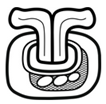| CMGG entry for syllabogram tzi
|
|
Variant: dot cascade
MC TOK.p32.r5.c4
MC JM TOK.p10.r2.c3
MC K&H JM TOK.p13.r5.c3 T507a&b
Coll-1 TNA Monument 171 B1 ta.<pi:tzi>
TOK.p23.r4.c3 MHD.PL7.2 0507hh = Prager-DdEdM.t0:31:57
MHD.PL7.1 Graham TNA Monument 141 D4b *pi:*tzi:la
Sub-variants (4) · A. Abstract full form: o Top – a trifoliate “crest”: § With the outside leaves curling respectively to the left and right, and slightly downwards. § Central leaf with smooth top (no tip pointing upwards). § The leaves optionally with spines. o Bottom – Boulder, with inside: § Top: circle (often bold), with arc inside (slightly “LEM”-like). § Middle: three lines of cascading non-touching dots (each dot in the cascade growing smaller the further down it is): · Left: slightly curved. · Middle: straight down. · Right: slightly curved. § Bottom (T507a&b show that this is optional): · Top: lipped-U. · Bottom: two parallel vertical bands, optionally slightly curved outwards. · B. Crest only = Abstract full form reduced to only the trifoliate element (“considerably reduced”). · C. Boulder only = Abstract full form reduced to only the boulder element (“slightly reduced”). · D. Head form: o An anthropomorphic head with a “LEM” at the top and a 3-pronged “shower of dots” and the lipped-U with column supports infixed. (0507hh and MHD.PL7.1 show that the lipped-U with column supports is optional). o The 3-pronged “shower of dots” is sometimes not that obvious, as in MHD.PL7.1 and TNA Monument 141 D4b. The latter occurs in a context where we expect pitzil, which is how we know that that head glyph is tzi. o The distance from 0507hh to MHD.PL7.1 is small, and perhaps the distance from MHD.PL7.1 to TNA Monument 141 D4b is also small, but leads to quite a large distance from the first to the last. o The 3-pronged “shower of dots” could become just the middle prong, e.g. from erosion, as shown by TNA Monument 171 B1. This helps to make the reading of the head variants more plausible.
|
|
Variant: pax-ja
JM.244.#1 TOK.p14.r5.c4 MHD.ZU5 1709st tzo ? tzi? -
· This is a glyph that is not listed in almost all the standard tables of syllabograms, not even those which show quite uncommon ones. · JM.244.#1 (2002) lists it as tzo and describes it as a “sprout emerging from a ‘moon’ sign”. · Very similar to TOK.p14.r5.c4 (2017), which is given with “?”. · Very similar to MHD.ZU5 (2022 onwards), which is given with tzi?. · Very similar to Bonn’s 1709st (2022 onwards), which is not given a reading. · Summary: tzo is probably now outdated, with a very tentative reading of tzi?.
|















